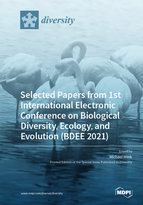Selected Papers from 1st International Electronic Conference on Biological Diversity, Ecology, and Evolution (BDEE 2021)
A special issue of Diversity (ISSN 1424-2818). This special issue belongs to the section "Phylogeny and Evolution".
Deadline for manuscript submissions: closed (20 July 2021) | Viewed by 54096
Special Issue Editor
Interests: phytochemistry; molecular pharmacology of medicinal and toxic plants; alkaloids; evolution; chemical ecology; ornithology; phylogeny and evolution
Special Issues, Collections and Topics in MDPI journals
Special Issue Information
Dear Colleagues,
The 1st International Electronic Conference on Biological Diversity, Ecology and Evolution (BDEE 2021), sponsored by the MDPI open access journal Diversity, will be held online from 15 to 31 March 2021. This event enables researchers in the science of biodiversity to present their research and exchange ideas with their colleagues without the need for travel. All proceedings will be published on the conference homepage in open access format.
Through this event, we aim to cover the following topics:
- Marine diversity
- Animal diversity
- Plant diversity
- Microbial diversity and culture collections
- Chemical biodiversity and chemical ecology
- Biodiversity conservation
- Biogeography and macroecology
- Phylogeny and evolution
- Biodiversity loss and dynamics
- Mesophotic ecosystems diversity
- Invasive species and diversity
The conference will be completely free of charge—both to attend, and for scholars to upload and present their latest work on the conference platform.
For selected papers that were presented at the congress authors are invited to submit their extended versions to this Special Issue of the journal Diversity after the conference, with 20% discount on the fees. Submitted papers should be extended to the size of regular research or review articles, with at least a 50% extension of new results. All submitted papers will undergo our standard peer-review procedure. Accepted papers will be published in open-access format in Diversity and collected together in the Special Issue website. There are no page limitations for this journal.
Prof. Dr. Michael Wink
Guest Editor
Manuscript Submission Information
Manuscripts should be submitted online at www.mdpi.com by registering and logging in to this website. Once you are registered, click here to go to the submission form. Manuscripts can be submitted until the deadline. All submissions that pass pre-check are peer-reviewed. Accepted papers will be published continuously in the journal (as soon as accepted) and will be listed together on the special issue website. Research articles, review articles as well as short communications are invited. For planned papers, a title and short abstract (about 100 words) can be sent to the Editorial Office for announcement on this website.
Submitted manuscripts should not have been published previously, nor be under consideration for publication elsewhere (except conference proceedings papers). All manuscripts are thoroughly refereed through a single-blind peer-review process. A guide for authors and other relevant information for submission of manuscripts is available on the Instructions for Authors page. Diversity is an international peer-reviewed open access monthly journal published by MDPI.
Please visit the Instructions for Authors page before submitting a manuscript. The Article Processing Charge (APC) for publication in this open access journal is 2600 CHF (Swiss Francs). Submitted papers should be well formatted and use good English. Authors may use MDPI's English editing service prior to publication or during author revisions.






